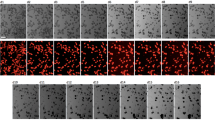Abstract
The purpose of this study was to develop and characterize a cardiomyocyte culture system for use as an experimental model to study the mechanism(s) by which cardiac muscle cells permanently exit the cell cycle during early neonatal life. Ventricular cardiomyocytes, isolated by retrograde perfusion of hearts from 21-day-old and adult rats, were compared through 10 days of culture. Expression patterns of genes encoding developmentally programmed proteins were determined to be similar between cardiomyocytes cultured from 21-day-old and adult rats, using the reverse transcription polymerase chain reaction. A lacZ-expressing reporter gene was used to test the efficiency of gene delivery in cultured cardiomyocytes. Transfections using cationic liposomes yielded 24 ± 7, 25 ± 7 and 10 ± 1% cardiomyocytes positive for β-galactosidase activity in cultured 1-day, 21-day and adult cardiomyocytes, respectively. Direct needle microinjection resulted in 48 ± 7, 35 ± 6 and 37 ± 5% cardiomyocytes positive for enzymatic activity in 1-day, 21-day and adult cardiomyocytes, respectively. Cell cycle-specific cDNA arrays were used to analyze the expression pattern of cell cycle-related genes in 12-O-tetradecanoyl-phorbol-13-acetate (TPA)- and non-TPA-treated cultured 21-day cardiomyocytes. Based on the similarity of cultured 21-day to adult ventricular cardiomyocytes and their high transfection efficiencies, we propose the use of cultured cardiomyocytes from 21-day-old rat ventricles as an experimental model system for the study of adult cardiomyocyte gene expression and cell cycle machinery.
Similar content being viewed by others
References
Claycomb WC, Moses RL: Growth factors and TPA stimulate DNA synthesis and alter the morphology of cultured terminally differentiated adult rat cardiac muscle cells. Dev Biol 127: 257–265, 1988
Blondel B, Roijen I, Cheneval JP: Heart cells in culture: A simple method for increasing the proportion of myoblasts. Experientia 27: 356–358, 1971
Claycomb WC, Lanson N Jr: Isolation and culture of the terminally differentiated adult mammalian ventricular cardiac muscle cell. In vitro 20: 647–651, 1984
Claycomb WC, Palazzo MC: Culture of the terminally differentiated adult cardiac muscle cell: A light and scanning electron microscope study. Dev Biol 80: 466–482, 1980
Claycomb WC, Lanson NA Jr, Stallworth BS, Egeland DB, Delcarpio JB, Bahinski A, Izzo NJ Jr: HL-1 cells: A cardiac muscle cell line that contracts and retains phenotypic characteristics of the adult cardiomyocyte. Proc Natl Acad Sci USA 95: 2979–2984, 1998
Bartoli M, Claycomb WC: Transfer of macromolecules into living adult cardiomyocytes by microinjection. Mol Cell Biochem 172: 103–109, 1997
Lanson NA Jr, Glembotski CC, Steinhelper ME, Field LJ, Claycomb WC: Gene expression and atrial natriuretic factor processing and secretion in cultured AT-1 cardiac myocytes. Circulation 85: 1835–1841, 1992
Delcarpio JB, Lanson NA Jr, Field LJ, Claycomb WC: Morphological characterization of cardiomyocytes isolated from a transplantable cardiac tumor derived from transgenic mouse atria (AT-1 cells). Circ Res 69: 1591–1600, 1991
Eghbali M, Blumenfeld OO, Seifter S, Buttrick PM, Leinwand LA, Robinson TF, Zern MA, Giambrone MA: Localization of types I, III and IV collagen mRNAs in rat heart cells by in situ hybridization. J Mol Cell Cardiol 21: 103–113, 1989
Bienkowski RS, Cowan MJ, McDonald JA, Crystal RG: Degradation of newly synthesized collagen. J Biol Chem 253: 4356–4363, 1978
Lundgren E, Terracio L, Borg TK: Adhesion of cardiac myocytes to extracellular matrix components. Basic Res Cardiol 80 (suppl 1): 69–74, 1985
Terracio L, Rubin K, Gullberg D, Balog E, Carver W, Jyring R, Borg TK: Expression of collagen binding integrins during cardiac development and hypertrophy. Circ Res 68: 734–44, 1991
Borg TK, Rubin K, Lundgren E, Borg K, Obrink B: Recognition of extracellular matrix components by neonatal and adult cardiac myocytes. Dev Biol 104: 86–96, 1984
Oparil S, Bishop SP, Clubb FJ Jr: Myocardial cell hypertrophy or hyperplasia. Hypertension 6:III 38–43, 1984
Claycomb WC: DNA synthesis and DNA enzymes in terminally differentiating cardiac muscle cells. Exp Cell Res 118: 111–114, 1979
Claycomb WC: Biochemical aspects of cardiac muscle differentiation. Deoxyribonucleic acid synthesis and nuclear and cytoplasmic deoxyribonucleic acid polymerase activity. J Biol Chem 250: 3229–3235, 1975
Eppenberger-Eberhardt M, Flamme I, Kurer V, Eppenberger HM: Reexpression of alpha-smooth muscle actin isoform in cultured adult rat cardiomyocytes. Dev Biol 139: 269–278, 1990
Author information
Authors and Affiliations
Corresponding author
Rights and permissions
About this article
Cite this article
Lam, M.L., Bartoli, M. & Claycomb, W.C. The 21-day postnatal rat ventricular cardiac muscle cell in culture as an experimental model to study adult cardiomyocyte gene expression. Mol Cell Biochem 229, 51–62 (2002). https://doi.org/10.1023/A:1017999216277
Issue Date:
DOI: https://doi.org/10.1023/A:1017999216277




